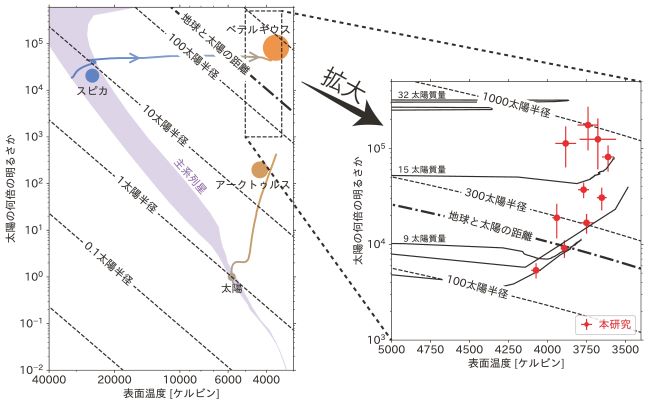
Massive stars, stars about nine times heavier than that of the Sun, evolve to red supergiants, which is a class of red luminous stars. Atmospheric properties of red supergiants, such as effective temperatures, pulsation, and mass loss, are important observables to understand the evolutionary path of massive stars towards supernova explosions.
Effective temperatures of red supergiants are important to examine a evolutionary model of massive stars. To determine the temperatures, several methods have been used; for example, determination of the radius using interferometry and determination of the molecular TiO-band strength using optical spectroscopy. However, there were systematic differences in the effective temperatures determined by different methods, and it has been unknown which method gives the accurate value. This is partly due to the difficulty in accurately modeling the complex structure of the upper atmospheres of red supergiants.
Thus, we have established a new, empirical method to determine the effective temperatures of red supergiants using iron atomic lines, which are expected to be less affected by the upper atmospheres. We calibrated the relations between effective temperatures and line-depth ratios using red giants whose temperatures have been accurately determined, and we applied these relations to red supergiants. Using this method, we determined the effective temperatures of 10 nearby red supergiants, and found that their temperatures are in good agreement with those predicted by a stellar evolution model.

Please refer to the published paper for more detail.
Time variability of red supergiant stars, such as the pulsation and mass loss, is an important research target in stellar astronomy because it affects the evolutionary track of massive stars, the light curves of subsequent supernovae, and so on. In early 2020, there was an event which is useful to understand the variability—the Great Dimming of Betelgeuse. Betelgeuse is one of the nearest red supergiants, and usually is a first-magnitude semi-regular variable star with the amplitude of around 0.3 magnitudes. Against this usual time variation, the optical brightness of Betelgeuse had fallen suddenly since late 2019, and recorded a historical minimum of V = 1.6 magnitudes in early 2020, and then went back to its usual brightness. This rapid fall and rise in the optical of Betelgeuse is called "the Great Dimming."
In order to solve the mystery of the Great Dimming, we focused on the images taken by a Japanese meteorological satellite called Himawari-8. The main targets of the Himawari-8 observation are, of course, the surface and atmosphere of the Earth, but taking a closer look, one can find that there is the outer space around the edge of the Earth's disk. We realized that there is Betelgeuse in this outer space region. Then, we analyzed the 4.5-year images taken by the Himawari-8 satellite, and obtained the 16-band light curves of Betelgeuse in the optical to mid infrared (0.45–13.5 μm). Analyzing these light curves using a theoretical model, we revealed that the Great Dimming may have been caused by the combination of the cooling of the stellar surface and the occultation by a newly-formed dust cloud just in front of the star.
Please refer to the published paper for more detail.